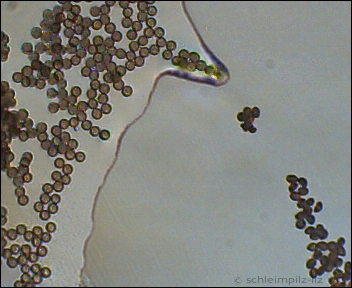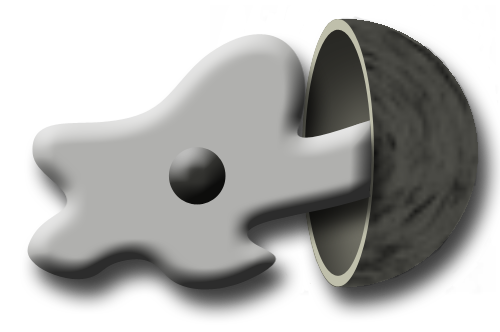
Sporen - was ist das?
Sporen - das sind für Pilze und Schleimpilze in etwa ein Ersatz für Samen. Was bei Pflanzen jedoch auf dem geschlechtlichen Weg geschieht (Bestäubung!), läuft bei der Bildung von Sporen ganz ungeschlechtlich ab. Dennoch dienen Sporen dem gleichen Zweck: der Fortpflanzung.
What are spores?
Spores could be described as a replacement for seeds for mushrooms and slime molds. While plants use sexuality (pollination!), spores are formed in a monogenous way. Yet, spores serve the same purpose as seeds: reproduction.
Sie sind so klein, dass wir Menschen sie eigentlich nur als Staub wahrnehmen können. Der Wind kann sie problemlos in alle Richtungen verteilen, ebenso tragen kleine Tiere wie Insekten zu ihrer Verbreitung bei. They are so small that we humans can only perceive them as dust. The wind can easily transport them in all directions. Small animals, such as insects, also contribute to their distribution.
Wie sehen Sporen von Schleimpilzen aus?
Tja, klein und rund zunächst einmal. Schaut man sie sich jedoch sehr genau an (dazu braucht man dann allerdings ein Rasterelektronenmikroskop), kann man unterschiedlichste Oberflächenstrukturen erkennen - von rau über rissig, warzig, stachelig bis aalglatt oder netzartig. Raue Oberflächen können bewirken, dass der Wind die Sporen sehr weit trägt, da ihm eine gute Angriffsfläche geboten wird. In diesen kleinen Kapseln befindet sich das Erbmaterial, die DNA. Diese ist auf einem einfachen (haploiden) Chromosomensatz gespeichert. Auch die Farben sind sehr unterschiedlich: Die Sporenmasse erscheint in der Regel in Weiß- Grau-, Beige- oder Rosatönen, kann aber auch kräftige Rot- Gelb-, Orange-, Braun-, Olive- oder Schwarztöne annehmen. Dabei kann die Sporenmasse auch ganz anderer Farbe als die einzelne Spore sein¹.
What do slime mold spores look like?
Well, small and round, first and foremost. However, if you take a closer look (using a scanning electron microscope), you can see different surface textures - from rough to chapped, warty, spiky to slick or meshed. Rough surfaces can help the wind carry the spores very far, since they provide a large attack surface for air. The genetic material of the slime mold, the DNA, can be found within these small capsules. It is saved on a simple (haploid) chomosome set. Just like the texture, the spore's color can vary, too: usually, bulks of spores appear in different shades of white, grey, beige or pink, but they can also take on bright shades of red, yellow, orange, brown, olive or a deep black. The bulk of spores can appear in a different color than the single spore¹.

Sporen der Art Physarum polycephalum in 20-facher Vergrößerung - links in einem Wassertropfen, rechts im Trockenen Spores of Physarum Polycephalum, 20-fold magnification - left side in a drop of water, right side in the dry
Sporenkeimung
Die Sporen beginnen zu keimen, wenn sie für längere Zeit Kontakt mit Feuchtigkeit haben und die Temperaturverhältnisse stimmen. Sporen brauchen unterschiedlich lange zum keimen und bleiben auch über Jahre hinweg noch keimfähg (längster Rekord im Labor: 75 Jahre). Auch gibt es Schleimpilzarten, die nur unter einer geschlossenen Schneedecke keimen (die sogenannten "nivicolen" Arten), andere Sporen wiederum keimen nur bei Temperaturen über 20 Grad. Somit besitzt jede Schleimpilzart ihr Optimum an Feuchtigkeit und Temperatur.
Nachgewiesen ist, dass Sporenmassen besser keimen als einzelne Sporen, manche Schleimpilzarten brauchen gar eine Ruhephase, bevor die Sporen anfangen zu keimen¹.
Bei der Keimung platzen die Sporenhüllen auf und kleine Protoplasten schlüpfen heraus. Abhängig von der Feuchtigkeit entstehen nun aus den Protoplasten entweder Myxoflagellaten oder Myxamöben - die Keimzellen (Gameten) der Schleimpilzen.
Germination
The spores begin to germinate once they have been in contact with moisture for a longer period of time and the temperature is right. The time spores need to germinate can vary and they stay germinable for many years (longest record in the lab: 75 years). Some kinds of slime molds only germinate below a closed cover of snow (the so-called "nivicole" kinds), other spores only germinate at temperatures above 20 degrees Celcius. Therefore, every slime mold kind has its own notion of ideal humidity and temperature conditions.
Research has shown that bulks of spores germinate easier than individual spores and some spores need a dormant phase before germination ¹.
During germination, the surface of the spores burst and small protoplasts hatch. Depending on the humidity conditions, these Protoplasts turn into Myxoflagellates or Myxamoebae - the germ cells (gametes) of slime molds.
